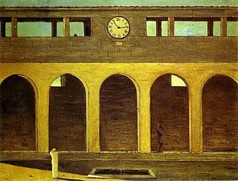
Giorgio de Chirico and the Paintings Which Cannot be Seen
Phillip Barcio | Ideelart | 30th August 2020
To declare de Chirico’s paintings “non-interpretable except for the mood” sounds about right. He reached adulthood in fin de siècle Europe which was struggling with a sense of loss as its present was “rapidly being gobbled up by a ravenous future”. His signature motif was the strange cityscape – empty piazzas, arcades lit by a late afternoon sun, perhaps a distant train. Far from utopian scenes, they were his attempt to “depict not the thing but the effect it produces.”
